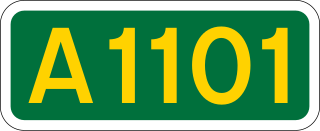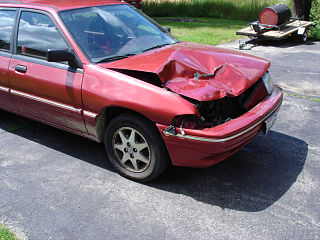
The A5 is a major road in England and Wales. It runs for about 252 miles (406 km) from London to the Irish Sea at the ferry port of Holyhead. In many parts the route follows that of the Roman Iter II route which later took the Anglo-Saxon name Watling Street.

Road traffic safety refers to the methods and measures used to prevent road users from being killed or seriously injured. Typical road users include pedestrians, cyclists, motorists, vehicle passengers, horse riders, and passengers of on-road public transport.

The European New Car Assessment Programme is a European voluntary car safety performance assessment programme based in Leuven (Belgium) formed in 1996, with the first results released in February 1997. It was originally started by the Transport Research Laboratory for the UK Department for Transport, but later backed by several European governments, as well as by the European Union. Their slogan is "For Safer Cars".

IAM RoadSmart formerly called the Institute of Advanced Motorists (IAM) is a charity based in the United Kingdom and serving nine countries, whose objective is to improve car driving and motorcycle riding standards, and so enhance road safety, by using the British police's system of car and motorcycle control commonly known as "the System". The System was devised in 1937 by racing driver Mark Everard Pepys, 6th Earl of Cottenham, to reduce accidents in police pursuits.

The A53 is a primary route in the English Midlands, that runs from Buxton in Derbyshire to Shrewsbury in Shropshire.

The A54 road is a road in England linking Chester in Cheshire with Buxton in Derbyshire. Its route through both urban and steep rural areas presents a challenge to Cheshire County Council in maintaining the safety of the road. Many years ago it was the main east–west route in Cheshire. The importance of the A54 through Middlewich and Winsford decreased in the 1970s and 1980s with the building of the M56 motorway and dualling of the A556 at Northwich. The section through Winsford carries approximately 30,000 vehicles per day.
The Royal Automobile Club of Spain, is a motor club/car club in Spain.

The United Kingdom has a network of roads, of varied quality and capacity, totalling about 262,300 miles (422,100 km). Road distances are shown in miles or yards and UK speed limits are indicated in miles per hour (mph) or by the use of the national speed limit (NSL) symbol. Some vehicle categories have various lower maximum limits enforced by speed limiters. A unified numbering system is in place for Great Britain, whilst in Northern Ireland, there is no available explanation for the allocation of road numbers.

The A1079 is a major road in Northern England. It links the cities of York and Kingston upon Hull, both in Yorkshire. The road is noted for its past safety issues, and regularly features in the Road Safety Foundations reports on Britain's most dangerous roads. Campaigners have been calling for the entire route to be made into a dual carriageway.

The Cat and Fiddle is a road in England between Buxton, Derbyshire, and Macclesfield, Cheshire, named after the Cat and Fiddle Inn public house at its summit. Formed by parts of the A537, A54 and A53, it is famous for its scenic views across the Greater Manchester conurbation, the Peak District National Park and the Cheshire Plain, and for its many bends. It is extremely popular with motorcyclists, and is often classed as the most dangerous road in the United Kingdom.

The A1101 is the lowest road in Great Britain; along its 53 miles (85 km) approx. stretch it rarely rises above sea level. It is also the longest 4 digit A road in Great Britain at 53.5 miles (86 km). The road runs from Bury St. Edmunds north west to Littleport where it disappears for approximately 2 miles (3.2 km), it then re-appears on the other side of the A10 heading north through Wisbech and to its end at the A17 in Long Sutton. The A1101's route takes it across the Fens in Lincolnshire and Norfolk, a low-lying area to Suffolk through Cambridgeshire. It is the main road for access between Lincolnshire and the Fenlands and the only road to directly link Suffolk with Lincolnshire. The stretch between Wisbech and Long Sutton was previously designated the A150.
European Road Assessment Programme (EuroRAP) is an international nonprofit (vzw) organisation registered in Belgium. It operates from Worting House, Basingstoke, Hampshire.

The International Road Assessment Programme or iRAP assesses roads all over the world and aims to significantly reduce road casualties by improving the safety of road infrastructure.

The Polski Związek Motorowy is an automobile club and the governing body of motorsports in Poland. It is based in Warsaw.
Vision Zero is a multi-national road traffic safety project that aims to achieve a highway system with no fatalities or serious injuries involving road traffic. It started in Sweden and was approved by their parliament in October 1997. A core principle of the vision is that "Life and health can never be exchanged for other benefits within the society" rather than the more conventional comparison between costs and benefits, where a monetary value is placed on life and health, and then that value is used to decide how much money to spend on a road network towards the benefit of decreasing risk.

Road traffic collisions generally fall into one of five common types:
The Campaign for Safe Road Design is a partnership between 13 UK major road safety stakeholders that is calling for the UK Government to invest in a safe road infrastructure which in their view could cut deaths on British roads by 33%.
The European Campaign for Safe Road Design aims to influence the European Union to make safe road design a European transport priority and save unnecessary deaths on Europe's roads. The campaign is a partnership between 28 road safety stakeholders from across Europe, claiming that a formal safe road infrastructure initiative could reduce the number of killed and seriously injured by 50,000 per year in less than a decade, saving 0.5% of GDP - €50 billion, saving at least 300 deaths and serious injuries per day. The European campaign builds on the UK Campaign for Safe Road Design which has worked to influence the UK government since 2008.
Touring Club Belgium (TCB) is a motoring organisation providing roadside assistance, insurance, medical insurance and legal support throughout Belgium. TCB is a member of the FIA and ARCEurope.

Croatian Automobile Club is the main Croatian automobile association – such as American AAA or British AA. With over 227,000 members, it is one of the largest non-profit associations in Croatia. The club provides a number of services to members including technical assistance to drivers on the road, reporting on traffic and road congestion in Croatia, and administering International Driving Permits to Croatian drivers.














